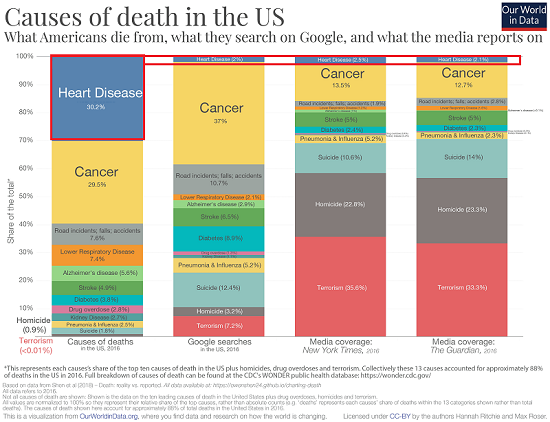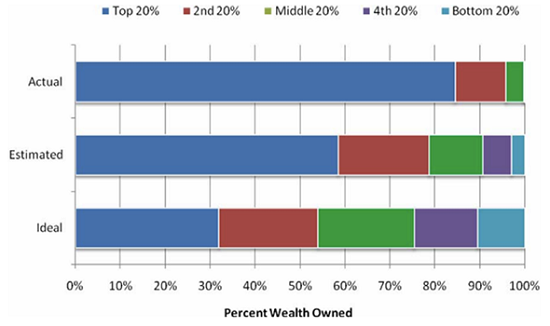Longtime correspondent J.F. (MD) recently shared a fascinating graphic ranking the leading causes of death in the U.S. (2016 data, pre-pandemic) compared to searches on Google and what the media reports. (see chart below) Note that this data isn't a survey asking people to rank the leading causes of death, but it does reflect what health topics they were interested in finding more about via web searches.
The media coverage of each cause of death is also not a representation of what the media presents as the leading causes of death; it's a reflection of the quantity of media coverage of each cause of death.
I'm making these stipulations because this reminded me of a similar chart which depicts three different views of wealth inequality in the U.S.: (see chart below)
1. The actual distribution of wealth
2. What survey respondents thought was the actual distribution of wealth
3. What survey respondents thought was the ideal distribution of wealth
This survey made quite a media splash when it was published a few years ago because wealth inequality was so much more extreme than what people thought and what they reckoned as ideal. Economic Inequality: It's Far Worse Than You Think: The great divide between our beliefs, our ideals, and reality.
Here's the source research: (Mis)perceptions of inequality
And here is a typical research presentation of just how extreme wealth inequality has become in the U.S.: Middle Class Now Holds Less Wealth than Top 1 Percent
Returning to the causes of death chart, note the remarkable disparity between the leading cause of death, heart disease, and the search and media coverage of heart disease. While heart disease causes almost a third of all deaths, the search results and media coverages were tiny fractions of the total searches/coverage.
Cancer has a higher profile, appearing in searches somewhat in proportion to its ranking as the #2 cause of death, also about a third. Media coverage of cancer was modest but far more significant than the coverage of heart disease.
Not surprisingly, the most dramatic and tragic causes of death--suicide, homicide and terrorism-- attracted the most media coverage, and a larger percentage of searches than the actual percentages of causes of death.
This may reflect the higher media coverage, the human interest in life-and-death situations and perhaps the often-noted skewing of our perceptions of risk to the dramatic (terrorism, aircraft crashes, shark attacks, etc.) rather than the mundane (heart disease).
I noticed an interesting "missing link" in the causes of death data: no mention was made of alcohol impairment as a cause of death, even though alcohol is clearly a factor in deaths from disease, homicide and motor-vehicle accidents.
J.F. noted that half of all homicides involve alcohol impairment: Strong alcohol policies help reduce alcohol-involved homicides (sciencedaily.com)
"In the U.S., between 40 and 50 percent of homicides involve the use of alcohol by either the victim or perpetrator, and more than half involve people who are significantly impaired by alcohol, which means that their blood alcohol levels are at or above 0.08 percent, the legal limit for driving."
About 30% of all vehicle fatalities involve alcohol impairment as well.
This means alcohol impairment is a direct causal influence in 8,000 murders and between 10,000 and 12,000 traffic deaths each year, plus the 95,000 people who die every year of alcohol-related diseases--a total of around 115,000 people annually.
That puts alcohol as the 7th leading cause of death in the U.S. If we include smoking as a key cause of respiratory diseases (160,000 deaths annually, the 4th leading cause) and lung cancer (142,000 deaths annually), tobacco and alcohol are key factors in 300,000+ deaths annually, right behind heart disease and all cancers. Deaths from Excessive Alcohol Use in the U.S. (CDC)
What are the leading causes of death in the US?
In stark contrast, cannabis use has no statistical effect on mortality. Though various authorities continue to claim cannabis is a "gateway drug," alcohol isn't a gateway; it's a major cause of death all by itself. The legal substance kills 115,000 users a year, and the illegal substance (Schedule 1, as dangerous as heroin according to our federal government) has no discernable impact on mortality.
The Health Effects of Cannabis and Cannabinoids: The Current State of Evidence and Recommendations for Research. (NCBI):
"After adjusting for confounders, including alcohol use, cigarette smoking, and demographic factors, individuals who reported using cannabis, but not other substances (i.e., cocaine, heroin, hallucinogens, inhalants), at baseline were not at increased risk of all-cause mortality compared with individuals who reported not using cannabis or other substances at baseline."
"After accounting for potential confounders, Andreasson and Allebeck (1990) found no statistically significant association between cannabis use and mortality."
Prohibition of alcohol didn't work as intended, and neither does the Prohibition of cannabis. Public health education, economic opportunities and healthier choices are the policy keys, not 10-year prison sentences.
This raises the question: how large a role does behavior play in the causes of death? Although it's an inexact calculation for obvious reasons, it's been estimated that roughly 2/3 of our health and longevity results from our behaviors and environment and only a third is the result of genetics.
The low search/media profile of heart disease suggests it's accepted almost as background noise rather than the #1 cause of death that is largely preventable by behavioral means: diet and fitness.
Many cancers also have behavioral factors. It's been well established that deficiencies in diet and fitness dramatically increase the risks of many cancers.
J.F. is a physician, and he reminds me that high blood pressure is a key indicator of cardio-vascular risk. You've probably heard this from your doctor and from health-related literature / research.
In past posts, I've covered the remarkable discoveries being made about the profound impacts of the microbiome on our health. All the research on the importance of the microbiome reaches the same conclusion: the more diverse real food rich in fiber, the better.
Mental Health May Depend on Creatures in the Gut
The microbiome thrives on a diverse diet of real (non-processed) foods rich in fiber. The connection between wealth and health is well-established, and while much of the correlation is attributed to the high cost of healthy food, beans and brown rice are not expensive, and neither are ethnic vegetables in season. Widening how we shop and cook need not cost a fortune. Rather, once the money being squandered on fast food (garbage in, garbage out) is spent on real food (assuming every ounce is eaten rather than thrown away), household spending on food may well drop dramatically.
Dietary effects on human gut microbiome diversity
How the Western Diet Has Derailed Our Evolution: Burgers and fries have nearly killed our ancestral microbiome.
I've also covered the dramatic positive effects of regular modest exercise. As a generality, the 80/20 Rule (the Pareto Distribution) applies to exercise: the first 20% of regular exercise generates 80% of the positive results. For example, walking an extra 2 miles a day will generate most of the benefits gained by walking more than 2 miles.
As we all know, the trick is to form habits of fitness that are akin to brushing our teeth-- or even better, of course, find types of fitness that we enjoy.
If health is wealth, and it most certainly is the highest form of wealth, then we would be well-served to take charge of our health-wealth in terms of what behaviors we can sustainably modify that will increase our health-wealth over the long-term. (Or put another way, what can we do to lower the risk factors that are within our control?)
Our choices and habits have an enormous impact on our health and health risks. Even modest changes can have life-changing positive results over time once they become our new set-point.


This essay was first published as a weekly Musings Report sent exclusively to subscribers and patrons at the $5/month ($54/year) and higher level. Thank you, patrons and subscribers, for supporting my work and this free blog.
If you found value in this content, please join me in seeking solutions by becoming a $1/month patron of my work via patreon.com.
My new book is available! A Hacker's Teleology: Sharing the Wealth of Our Shrinking Planet 20% and 15% discounts (Kindle $7, print $17, audiobook now available $17.46)
Read excerpts of the book for free (PDF).
The Story Behind the Book and the Introduction.
Recent Podcasts:
AxisOfEasy Salon #40: Subprime Attention NFTs (1:01 hrs) --NFTs--non-fungible tokens...
Disconnects between the Economy and the Financial Markets (FRA Roundtable, 41 min)
My COVID-19 Pandemic Posts
My recent books:
A Hacker's Teleology: Sharing the Wealth of Our Shrinking Planet (Kindle $8.95, print $20, audiobook $17.46) Read the first section for free (PDF).
Will You Be Richer or Poorer?: Profit, Power, and AI in a Traumatized World
(Kindle $5, print $10, audiobook) Read the first section for free (PDF).
Pathfinding our Destiny: Preventing the Final Fall of Our Democratic Republic ($5 (Kindle), $10 (print), ( audiobook): Read the first section for free (PDF).
The Adventures of the Consulting Philosopher: The Disappearance of Drake $1.29 (Kindle), $8.95 (print); read the first chapters for free (PDF)
Money and Work Unchained $6.95 (Kindle), $15 (print) Read the first section for free (PDF).
Become a $1/month patron of my work via patreon.com.
NOTE: Contributions/subscriptions are acknowledged in the order received. Your name and email remain confidential and will not be given to any other individual, company or agency.
|
Thank you, N. Callaghan S. ($50), for your superbly generous contribution to this site -- I am greatly honored by your support and readership. |
Thank you, Gail M. ($5/month), for your marvelously generous pledge to this site -- I am greatly honored by your support and readership. |
